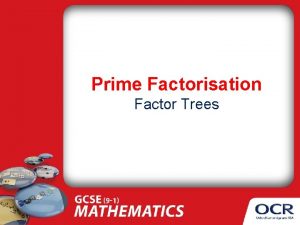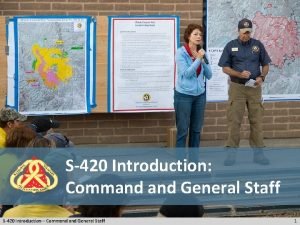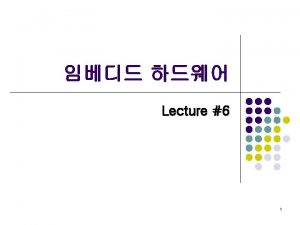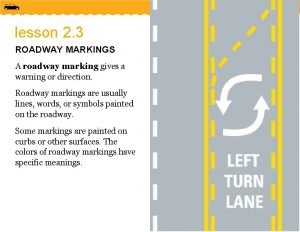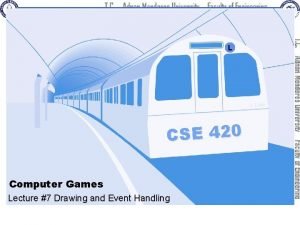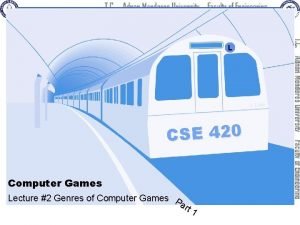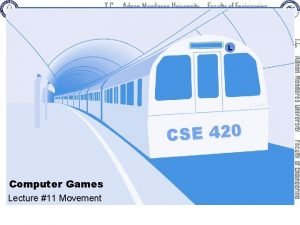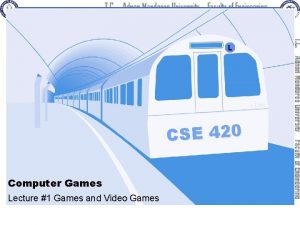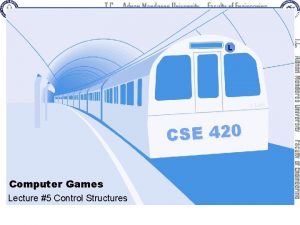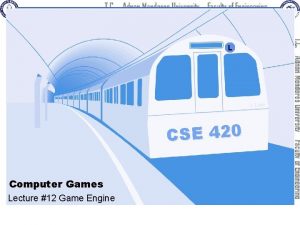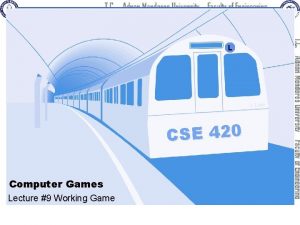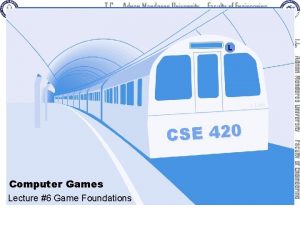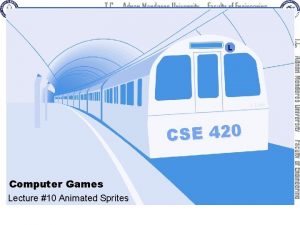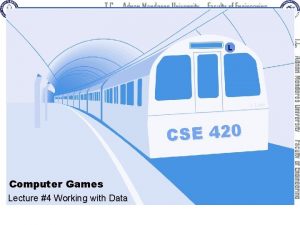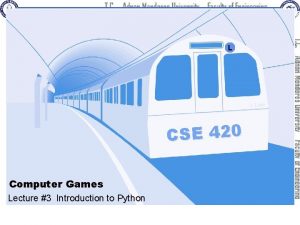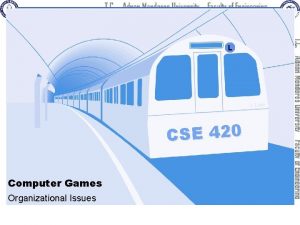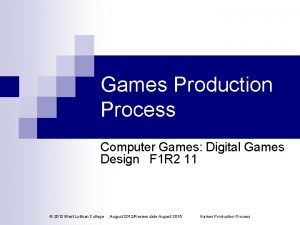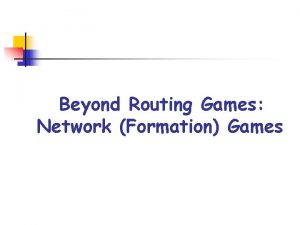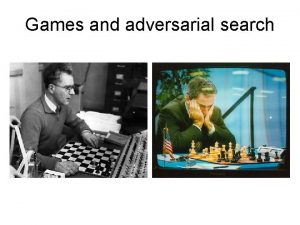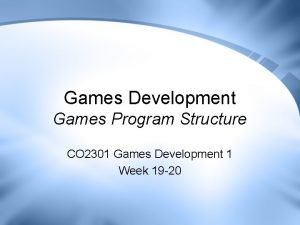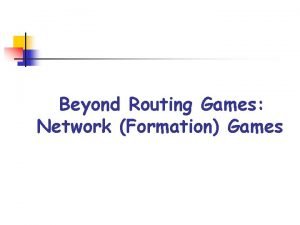L L Line CSE 420 Computer Games Lecture


















































































- Slides: 82

L L Line CSE 420 Computer Games Lecture #2 Genres of Computer Games P art 2

Objectives n n n Know the different types of vehicle simulation games Know how the design of the game world influences the player’s perception of speed Know some ways to design artificial opponents for the game Lecture #2 Genres of Comp. Games 2

Objectives (Cont. ) n n Understand the distinctions between military and civilian flight simulations Be familiar with the various views often used in vehicle simulation interfaces Lecture #2 Genres of Comp. Games 3

Objectives (Cont. ) n n n Know the definition of a construction and management simulation Know the differences between plan-and-build and purchase-and-place gameplay mechanics Know the basic gameplay modes and artificial behaviors common to this genre Lecture #2 Genres of Comp. Games 4

Objectives (Cont. ) n n Understand the issues facing a designer for user interface for this genre Understand the core mechanics of economies, construction, and management Lecture #2 Genres of Comp. Games 5

Objectives (Cont. ) n n Know the definition of an adventure game and the common game features of the genre Understand the importance of character and story in the genre Describe the different interaction models and perspectives common to adventure games Understand how to use puzzles and inventory in designing an adventure game Lecture #2 Genres of Comp. Games 6

Objectives (Cont. ) n n Know the different forms of artificial life games and simulations Design basic artificial life systems Know the steps to designing puzzle games Understand the player’s needs for puzzle games Lecture #2 Genres of Comp. Games 7

What Are Vehicle Simulations? n n n Feels like driving, flying, or controlling a vehicle Simulations vary from realistically handling the vehicle to adding game mechanics such as combat, racing, and special challenges Space and water vehicle simulations follow the same fundamental features as flying and driving simulations Lecture #2 Genres of Comp. Games 8

Game Features n Flight simulators q q n Civilian flight simulators are realistic and don’t include combat Military flight simulators are simplified but provide tactical conflict as well as physical challenges Driving simulators q q Organized racing is driving in an existing racing class; requires licensing Imaginary racing uses imaginary situations Lecture #2 Genres of Comp. Games 9

Game Features (Cont. ) n Players q q Purists demand highly accurate simulations of real vehicles Casual players don’t care about the details as long as they can fly or drive Lecture #2 Genres of Comp. Games 10

Game Features (Cont. ) n The player’s role q q Flight simulators—pilot or military positions such as navigator or bombardier Racing-oriented driving games—driver or mechanic Lecture #2 Genres of Comp. Games 11

Game Features (Cont. ) n Competition modes q q Military flight simulators—similar to first-person shooters Civilian flight simulators—single-player mode Driving simulators—single-player games or multiplayer races Military flight simulators and organized racedriving simulators—often include career mode and campaign mode Lecture #2 Genres of Comp. Games 12

Game Features (Cont. ) n Gameplay and victory conditions q q Primary challenge is controlling the vehicle Military flight sims must also achieve the mission objective n n q q Type of plane determines gameplay Many offer a series of missions Civilian flight sims seldom have victory conditions Organized racing sims take gameplay from the real races Lecture #2 Genres of Comp. Games 13

Core Mechanics n n Vehicle simulations are technologically oriented, so the core mechanics are almost entirely about physics Designing opponents q q Provide different vehicles with different characteristics Modify the behavior of individual opponents Lecture #2 Genres of Comp. Games 14

Core Mechanics (Cont. ) n Damage q q q Children’s games can ignore damage to the vehicle Damage can be modeled as a single variable like health points Accurate modeling divides the vehicle into areas n n Tracks damage in each individual area Computes damage’s effect on vehicle performance Lecture #2 Genres of Comp. Games 15

The Game World n n n Landscape is an important part of the entertainment Flight simulators—setting is the plane and the ground Driving simulators—racetrack, road, or offroad Weather affects vehicle handling Consider adding people to racetracks and airports to enhance immersion Lecture #2 Genres of Comp. Games 16

Other Vehicles n Boats and ships q q q Fluid medium changes handling characteristics, making it different from driving simulators Large warships simulated as parts of fleets Submarines are popular simulations Sailing simulations are rare Ocean is not modeled accurately n n Shoreline is usually correct Depth, tides, currents, reefs are not Lecture #2 Genres of Comp. Games 17

Other Vehicles (Cont. ) n Tanks and mechs q q n Rotating turret on tanks adds complexity Mech is an invented mechanism unrestricted by reality Spacecraft q q Majority of spacecraft simulations are science fiction Not modeled accurately—similar to fighter planes Lecture #2 Genres of Comp. Games 18

Intellectual Property Rights n n Generally, you can simulate military equipment without obtaining permission from the manufacturers To simulate an existing car or other civilian vehicle, you need a license from the manufacturer Lecture #2 Genres of Comp. Games 19

The Presentation Layer n n Interaction model—vehicle is the avatar; view through cockpit window Camera model q Views common to driving and flight simulators n n n Pilot’s/driver’s view—default Cockpit-removed view Chase view Rear, side, and front views Free-roaming camera Lecture #2 Genres of Comp. Games 20

The Presentation Layer (Cont. ) n Camera model (cont. ) q Views unique to military flight simulators n n q Ground target view Bomb or missile view Views unique to driving simulators n n n Track-side view Grandstand view Blimp view Lecture #2 Genres of Comp. Games 21

The Presentation Layer (Cont. ) n User interface design q q Biggest challenge is mapping vehicle’s real controls to those available on target machine Simplification n n q Military simulators require some simplification Flight simulators commonly simplify navigation Most flight simulators produce automatically coordinated flight Lecture #2 Genres of Comp. Games 22

The Presentation Layer (Cont. ) n User interface design (cont. ) q Creating the sense of speed—critical in driving simulations n n q Display a speedometer Vary the driving surface Include roadside objects Use sounds G-forces n n Military planes can show a G-force meter Pilots can black out or red out Lecture #2 Genres of Comp. Games 23

What Are Construction and Management Simulations? n n The majority of challenges are economic, concerned with growth Construction activity is an essential element of any CMS Pattern recognition and exploration challenges may also be present CMSs avoid physical challenges, as well as conflict challenges, unless they are hybrids with another genre Lecture #2 Genres of Comp. Games 24

Game Features n The player’s role q q It’s not easy to define the player’s role because that role seldom corresponds to an actual activity in real life The desire to create is in the heart of a CMS player Lecture #2 Genres of Comp. Games 25

Game Features (Cont. ) n Progression q q No levels or story Many begin with an empty space for players to start in from scratch Often have no victory condition, only loss Can also offer different scenarios for player to try n n Scenarios are partially built when player starts them Scenarios may have victory conditions as well as loss conditions Lecture #2 Genres of Comp. Games 26

Game Features (Cont. ) n Gameplay q Majority of CMSs are games of indirect control n n q The game simulates a process that the player can alter only in limited ways However, some actions, such as changing prices, use direct control Construction n n In most CMSs, actual act of construction is not a challenge Challenge is in obtaining resources needed for construction Lecture #2 Genres of Comp. Games 27

Game Features (Cont. ) n Gameplay (cont. ) q Purchase-and-place construction mechanism n Player buys an object and places it q n n q It is immediately ready for use Player can build objects quickly Resources used immediately Plan-and-build construction mechanism n n Player alternates between building and managing Player plans where to build, the computer then builds q n n Object not ready for use until construction is complete Player builds objects slowly Player must manage the resource flow Lecture #2 Genres of Comp. Games 28

Game Features (Cont. ) n Gameplay (cont. ) q Demolition n Allow players to demolish constructed items Set the cost for demolition Victory and loss conditions q q q Many CMSs do not have victory conditions Loss condition is bankruptcy Some scenarios can have victory conditions Lecture #2 Genres of Comp. Games 29

Game Features (Cont. ) n n Competition modes—single-player unless it’s a hybrid Simulating individual characters q q Some CMSs model behavior statistically for the whole group and do not simulate individuals Modeling individuals is more difficult n n Create a behavioral model for them Create a variable to track their happiness Base happiness on player’s skill at meeting their needs Statistics can be computed from all the individuals Lecture #2 Genres of Comp. Games 30

Game Features (Cont. ) n n Mind reading enables the player to see an individual’s needs and fulfillment status Advisors q q Provide alerts about local problems Notify the player of general conditions Set a threshold level at which the advisor will appear Allow players to turn off the advisor to add to challenge Lecture #2 Genres of Comp. Games 31

Game Features (Cont. ) n Pure business simulations q q Players construct financial fortunes, not visible objects Challenge—devise an economy and mechanisms for manipulating it Real challenge is to make the subject visually interesting Avoid runaway profits by controlling when and how a player can buy and sell Lecture #2 Genres of Comp. Games 32

Game Features (Cont. ) n Hybrid games q q Offer economic, exploration, and conflict challenges Design the economic aspects before adding other elements n n Other elements usually depend on the economy A mistake in the economy can ruin other parts of the game Lecture #2 Genres of Comp. Games 33

Core Mechanics n Resources q Primary resources n q Usually money and people Building materials n n Tangible entities in plan-and-build mechanics Intangible or not a resource in purchase-and-place mechanics Lecture #2 Genres of Comp. Games 34

Core Mechanics (Cont. ) n n The construction converter changes labor, money, and materials into buildings Drains and maintenance q q q n Drain permanently removes a resource Decay is the usual drain Maintenance can be automated Disasters force players to act Lecture #2 Genres of Comp. Games 35

The Game World n Setting q q q n Simulated physical space, usually outdoors Aerial perspective Often set in 2 D or 2. 5 D worlds Pure business simulations might not require a physical setting Lecture #2 Genres of Comp. Games 36

The Presentation Layer n Interaction model q q n Player is usually multipresent Walkthrough mode allows players to see the world in first-person perspective Camera model q q Isometric perspective is common 3 D environments allow players to zoom in and out, see a broad overview, or focus on a local problem Lecture #2 Genres of Comp. Games 37

The Presentation Layer (Cont. ) n User interface q q Interface can be more like standard computer software Display important scalar variables Graph can show values over time Vector variables describe related data, such as the amount of water available in different locations Lecture #2 Genres of Comp. Games 38

What Are Adventure Games? n n Interactive story about a protagonist Storytelling and exploration are essential elements Puzzle-solving and conceptual challenges form the majority of the gameplay Combat, economic management, and action challenges are reduced or nonexistent Lecture #2 Genres of Comp. Games 39

What Are Adventure Games? (Cont. ) n The original Adventure q q q Adventure was a text-only game First computer game to give the player a credible illusion of freedom First computer game that spoke to players like a person rather than a machine Lecture #2 Genres of Comp. Games 40

What Are Adventure Games? (Cont. ) n The growth of adventure games q q q Very popular in the early days of personal computers Having no graphics made games inexpensive to develop and allowed scope for imagination Developers added graphics when the technology became available Lecture #2 Genres of Comp. Games 41

What Are Adventure Games? (Cont. ) n Adventure games today q q q Market for adventure games has grown less steadily than the market for other genres Development of 3 D hardware improved graphics in adventure games Action-adventure games developed n q q This hybrid is now more popular than action or adventure Alternative solutions improves replayability Many players never complete the game Lecture #2 Genres of Comp. Games 42

Game Features n Setting and emotional tone q q Setting contributes more to the entertainment value of an adventure game than settings in any other genre Games move slowly, which gives designers the chance to create a world with a distinct emotional tone Lecture #2 Genres of Comp. Games 43

Game Features (Cont. ) n Interaction model q q n Always uses an avatar-based interaction model Early games used nonspecific avatar, but now avatar possesses his own personality Camera model q q Context-sensitive approach is traditional Third- and first-person games are becoming increasingly common Lecture #2 Genres of Comp. Games 44

Game Features (Cont. ) n Camera model (cont. ) q Context-sensitive model n n q Avatar is shown from the camera angle most appropriate for her current location in the game world Lets the designer play cinematographer, using camera angles, composition, and lighting to enhance the story First-person perspective n n Encourages a more action-oriented approach to playing Fewer opportunities for visual drama Lecture #2 Genres of Comp. Games 45

Game Features (Cont. ) n Camera model (cont. ) q Third-person perspective n n n Keeps the avatar in view Common in action-adventure games Best games allow the player to move the camera Lecture #2 Genres of Comp. Games 46

Game Features (Cont. ) n Player roles q q n Role of the player comes from the story Most adventure games treat the story as a journey Structure q q Establish a relationship between locations in the world and parts of the story Story became more linear in action-adventures Lecture #2 Genres of Comp. Games 47

Game Features (Cont. ) n Storytelling q Dramatic tension n n Arises from an unresolved situation or problem To create dramatic tension, start by presenting the problem The resolution of dramatic tension occurs at the dramatic climax, usually near the end of the story Adventure games can have several different dramatic climaxes for intermediate problems until the final climax solves the final problem and ends the story Lecture #2 Genres of Comp. Games 48

Game Features (Cont. ) n Storytelling (cont. ) q The heroic quest n n n The majority of adventure games are heroic quests: a mission by an individual to accomplish a great feat Biggest climax should be the last major climax in the game because anything that follows seems irrelevant Should be periods of quiet to rest and heal Lecture #2 Genres of Comp. Games 49

Game Features (Cont. ) n Storytelling (cont. ) q The problem of death n n In most genres (RPGs, combat flight simulators) death is accepted and players know what is likely to cause it In adventure games it is less clear Most adventure games adopt a fair warning approach, making it clear when something is dangerous and usually offering a way to neutralize the danger Use an autosave feature to save the game at intervals so the player can restore it later Lecture #2 Genres of Comp. Games 50

Game Features (Cont. ) n Challenges q q Majority of challenges are conceptual: puzzles that can only be solved by lateral thinking Puzzles include n n n Finding keys to locked doors Figuring out mysterious machines Obtaining inaccessible objects Manipulating people Navigating mazes n n n Lecture #2 Genres of Comp. Games Decoding cryptic messages Solving memorization puzzles Collecting things Doing detective work Understanding social problems 51

Game Features (Cont. ) n Conversations with nonplayer characters (NPCs) q q q An NPC’s conversation is defined by the NPC’s role, such as blacksmith or trader Some games try to sidestep the problem of conversation by setting games in underpopulated worlds Scripted conversations became standard Lecture #2 Genres of Comp. Games 52

Game Features (Cont. ) n Mapping q q n Graphics provide cues to location and how that location relates to other areas in the world Automapping—map fills in as the player moves Player can see the map at any time Provide a compass as well if appropriate Automatic journal keeping is common Lecture #2 Genres of Comp. Games 53

Game Features (Cont. ) n A few things to avoid q q q q Puzzles solvable only by trial and error Conceptual non sequiturs Illogical spaces Puzzles requiring outside knowledge Click-the-right-pixel puzzles Too many backward puzzles Too many Fed. Ex puzzles Lecture #2 Genres of Comp. Games 54

The Presentation Layer n Avatar movement q q Movement interface depends on the perspective Context-sensitive perspective uses point-and-click or direct control user interface n n q Point-and-click—indirect control Direct control—player steers the avatar Implement both walk and run modes Lecture #2 Genres of Comp. Games 55

The Presentation Layer (Cont. ) n Manipulating objects q Identifying active objects n n Hunt and click Permanently highlighted objects Dynamically highlighted objects Focus-of-attention highlighting Lecture #2 Genres of Comp. Games 56

The Presentation Layer (Cont. ) n Manipulating objects (cont. ) q q One-button actions—controller button or mouse click correctly manipulates the object Menu-driven actions n n Menu gives player the available choices Player can right-click an object to see a pop-up menu Lecture #2 Genres of Comp. Games 57

The Presentation Layer (Cont. ) n Manipulating objects (cont. ) q Managing inventory n n Most games limit the amount that can be carried Visible inventory mechanism like a backpack or box is common Make inventory management easy Open and close inventory with a single click or shortcut key Lecture #2 Genres of Comp. Games 58

Artificial Life Games n n Artificial life is a branch of computer science research A-life involves modeling biological processes A-life is the study of emergent properties— unanticipated qualities or behaviors that arise out of the interactions of complex systems A-life games typically focus on maintaining and growing a manageable population of organisms Lecture #2 Genres of Comp. Games 59

Artificial Life Games (Cont. ) n Artificial pets q q They can be simulations or fantasy pets Almost always cute; seldom reproduce or die Gameplay concentrates on training, maintenance, and watching the creatures Pet needs a lot of AI n n Variety of triggers and behaviors Show the pet's emotions through behavior Lecture #2 Genres of Comp. Games 60

Artificial Life Games (Cont. ) n Artificial pets (cont. ) q q q Player influences pet's emotions through interaction Pet should interact meaningfully with other pets Pet must be able to learn Rich AI distinguishes artificial pets from other Alife Artificial pet is a software toy—no victory condition Lecture #2 Genres of Comp. Games 61

Artificial Life Games (Cont. ) n The Sims q q q Player controls the sims physically and indirectly affects their relationships Each sim has a personality Cross between an artificial pet and a CMS—game has an economy Lecture #2 Genres of Comp. Games 62

Artificial Life Games (Cont. ) n The Sims (cont. ) q Needs n n n q Each sim has six needs that must be met Needs drive the sims' behavior Need-based AI is the heart of most simple behavior simulations Skills n n n Sims (in the first edition) have six skills they can improve Sims teach themselves skills Time management is critical Lecture #2 Genres of Comp. Games 63

Artificial Life Games (Cont. ) n The Sims (cont. ) q Personalities n n q Game tries to simulate relationships among individuals Variables define each sim's personality and how they react to each other Success of The Sims is based on the unprecedented scope for creativity it offers and its emphasis on interpersonal relationships Lecture #2 Genres of Comp. Games 64

Artificial Life Games (Cont. ) n Defining affinity between two characters: q q q The “I Can’t Stand” Rule – A character cannot stand another character who has an attribute above a certain threshold “Birds of a Feather” Rule – Characters with high levels of one attribute are attracted to others with a high level of the same attribute “Opposite Attract” Rule – Characters with high levels of one attribute are attracted to others with a low value for the same attribute Lecture #2 Genres of Comp. Games 65

Artificial Life Games (Cont. ) n God games q Characteristics n n n Player is a god with limited powers who gets more power from simulated worshippers Omnipresent interaction model and an aerial perspective They often share qualities with CMS (indirect control of population) and real-time strategy (compete directly against a rival god) games Lecture #2 Genres of Comp. Games 66

Artificial Life Games (Cont. ) n God games (cont. ) q The economy of god games n n n Player’s power (mana) grows with the number and prosperity of his worshippers Size of the population influences the maximum amount of mana the player may have and the rate at which mana is restored when it is below maximum Positive feedback can be limited in various ways: q q q People do not reproduce instantaneously Making land suitable for population growth costs mana Mana cost of using higher-level powers rises exponentially Lecture #2 Genres of Comp. Games 67

Artificial Life Games (Cont. ) n God games (cont. ) q Gameplay in god games n n q q Primary challenge is to produce population growth He must also damage the other god’s worshippers and repair the damage the rival god does to the player’s people To design a god game, start with the question of what powers you would like the god to have A god game needs a lot of interesting animations for the people Lecture #2 Genres of Comp. Games 68

Artificial Life Games (Cont. ) n Genetic A-life games q Characteristics n n n q They are about managing a population over time Player tries to achieve goals for the whole population Can’t concentrate too much on individuals Designing a genome n n Genome defines the creatures’ inheritable characteristics such as eye color, hair color, height, etc. Alleles are traits inherited from each parent q If parents have different traits, usually one wins—brown eye allele dominates blue eye allele Lecture #2 Genres of Comp. Games 69

Artificial Life Games (Cont. ) n Genetic A-life games (cont. ) q Mutation n n q Change to the gene caused by an environmental factor Mutations may benefit the population by introducing random new values into the gene pool Life span, maturity, and natural selection n n Each creature needs a natural life span To evolve through natural selection, creatures must have a time of immaturity before they can reproduce q Genetic mutations that cause death in children do not get passed on because children do not reproduce Lecture #2 Genres of Comp. Games 70

Artificial Life Games (Cont. ) n Genetic A-life games (cont. ) q What does the player do? n n Create new individuals and add them to the population to see how their genes influence the population Add and remove environmental hazards that would weed out certain genes Play with the rate and nature of mutation by adding or modifying mutagenic objects or areas of the environment Mate individuals to select for particular characteristics Lecture #2 Genres of Comp. Games 71

Puzzle Games n Characteristics q q In puzzle games, puzzle solving is the primary activity Puzzle games usually provide related challenges, variations on a theme The types of puzzles offered include pattern recognition, logic, or understanding a process The puzzles give the player clues that have to be solved to meet the victory condition Lecture #2 Genres of Comp. Games 72

Puzzle Games (Cont. ) n Scott Kim’s eight steps in puzzle game design q q Find inspiration Simplify Create a construction set Define the rules q q Construct the puzzles Test Devise a sequence Pay attention to presentation Lecture #2 Genres of Comp. Games 73

Puzzle Games (Cont. ) n What computers bring to puzzles q q q q Enable nonphysical or awkward moves Include computation features Enforce the rules Record player moves and undo them Structure the experience Teach Use bells and whistles Enable online play Lecture #2 Genres of Comp. Games 74

Puzzle Games (Cont. ) n Checking the victory condition q q Path to the solution might be different than you planned Check the solution, not the way it was reached Lecture #2 Genres of Comp. Games 75

Summary n You should now understand q q q How to identify different types of vehicle simulation games How to design vehicle attributes and characteristics How to create AI opponents How to list the requirements for a military simulation How to design the UI for a vehicle simulation Lecture #2 Genres of Comp. Games 76

Summary (Cont. ) n You should now understand q q q How to identify a construction and management simulation game How to describe the differences between plan-and -build and purchase-and-place gameplay mechanics How to use the basic gameplay modes and artificial behaviors common to this genre Lecture #2 Genres of Comp. Games 77

Summary (Cont. ) n You should now understand (cont. ) q q How to describe the issues facing a designer for user interface for this genre How to use the core mechanics of economies, construction, and management Lecture #2 Genres of Comp. Games 78

Summary (Cont. ) n You should now understand q q How to identify an adventure game How to explain the importance of character and story in the genre How to describe the different interaction models and perspectives common to adventure games How to use puzzles and inventory in designing an adventure game Lecture #2 Genres of Comp. Games 79

Summary (Cont. ) n You should now understand q q How to identify an artificial life game and simulation How to design basic artificial life systems How to describe the steps to designing puzzle games How to explain the player’s needs for puzzle games Lecture #2 Genres of Comp. Games 80

Next Lecture Introduction to Python 81

References n 82 Ernest Adams, Fundamentals of Game Design, 2 nd Edition, New Riders, 2016
 01:640:244 lecture notes - lecture 15: plat, idah, farad
01:640:244 lecture notes - lecture 15: plat, idah, farad Hunger games chapter 7
Hunger games chapter 7 Outdoor games and indoor games
Outdoor games and indoor games Differentiate between plain scale and diagonal scale
Differentiate between plain scale and diagonal scale Computer security 161 cryptocurrency lecture
Computer security 161 cryptocurrency lecture Computer aided drug design lecture notes
Computer aided drug design lecture notes Architecture lecture notes
Architecture lecture notes Isa definition computer
Isa definition computer Mini metric olympics worksheets answers
Mini metric olympics worksheets answers Arras penitenciais
Arras penitenciais Csci 420
Csci 420 Write 420 as a product of prime factors
Write 420 as a product of prime factors Factor tree of 108
Factor tree of 108 What is fixed vector
What is fixed vector Doe order 420
Doe order 420 Enve 420
Enve 420 Rosenberger hvs240
Rosenberger hvs240 Amg 420 discontinued
Amg 420 discontinued S-420 class
S-420 class Index currency option notes
Index currency option notes Dme #7 steel
Dme #7 steel Thursday420
Thursday420 Electivemed
Electivemed Mis-420
Mis-420 420 internet marketing
420 internet marketing Enve 420
Enve 420 Enve 420
Enve 420 Envee 420
Envee 420 Enve 420
Enve 420 Notice of confidential info rule 2-420
Notice of confidential info rule 2-420 Resolucion 420/2011
Resolucion 420/2011 420
420 Contemporary issues in marketing
Contemporary issues in marketing Simplest measure of dispersion
Simplest measure of dispersion Article 420
Article 420 420 position
420 position Zebra rw 420
Zebra rw 420 Falsecolor2
Falsecolor2 Enve 420
Enve 420 Cpsc 420
Cpsc 420 420 ucas points
420 ucas points 420 pst
420 pst The expanded form of ms word is
The expanded form of ms word is Nasvac
Nasvac Issues in operations management
Issues in operations management Cps 420
Cps 420 Wheel and axle in human body
Wheel and axle in human body Csci 420
Csci 420 420 разделить на 60
420 разделить на 60 Plato computer games
Plato computer games Opinion essay introduction
Opinion essay introduction Text computer games
Text computer games Ulysses poem explanation
Ulysses poem explanation Summary of the poem to daffodils by robert herrick
Summary of the poem to daffodils by robert herrick Thou blind mans mark
Thou blind mans mark Poem that has 14 lines
Poem that has 14 lines Simile from the poem taj mahal
Simile from the poem taj mahal Sonnet 60 explanation line by line
Sonnet 60 explanation line by line Sonnet 130 shakespeare rhyme scheme
Sonnet 130 shakespeare rhyme scheme Shakespeare sonnet 57 analysis
Shakespeare sonnet 57 analysis Sonnet 130 theme
Sonnet 130 theme Cellbit meaning
Cellbit meaning Act 2 prologue romeo and juliet
Act 2 prologue romeo and juliet Thomas wyatt farewell love summary
Thomas wyatt farewell love summary Thunderstorm poems
Thunderstorm poems Burning of the books by bertolt brecht
Burning of the books by bertolt brecht What is the metaphor in nothing gold can stay
What is the metaphor in nothing gold can stay Money madness explanation
Money madness explanation Special roadway markings
Special roadway markings Apostrophe to the ocean summary class 8
Apostrophe to the ocean summary class 8 Thou blind man's mark meaning
Thou blind man's mark meaning Futility (poem)
Futility (poem) Out out robert frost
Out out robert frost What type of poem is dreaming black boy
What type of poem is dreaming black boy Line coding adalah
Line coding adalah شرح قصيدة count that day lost بالعربي
شرح قصيدة count that day lost بالعربي Below the line vs above the line
Below the line vs above the line Analisi a valediction forbidding mourning
Analisi a valediction forbidding mourning One's self i sing poem analysis
One's self i sing poem analysis Multiview orthographic projection
Multiview orthographic projection Difference between simulation and dissimulation
Difference between simulation and dissimulation Lines composed a few miles above tintern abbey ... analysis
Lines composed a few miles above tintern abbey ... analysis The triumph of time line by line explanation
The triumph of time line by line explanation












